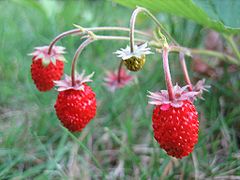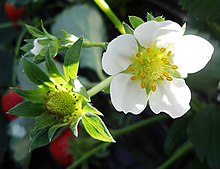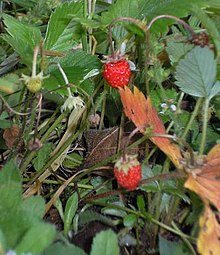Fragaria: Difference between revisions
rv nonsense. really weird nonsense... who adds "LOOOM" to an article about stawberries?!? |
|||
| Line 29: | Line 29: | ||
The rosette growth of the plants are a well-known characteristic. Most species send out long slender [[Stolon|runners]] that produce a new bud and roots at the extremity, allowing the plant to spread vegetatively. The leaves typically have three leaflets, but the number of leaflets may be five or one. |
The rosette growth of the plants are a well-known characteristic. Most species send out long slender [[Stolon|runners]] that produce a new bud and roots at the extremity, allowing the plant to spread vegetatively. The leaves typically have three leaflets, but the number of leaflets may be five or one. |
||
While the flower has the typical rosaceous structure, the fruit is very peculiar, but it may be understood by the contrast it presents with the [[rose hip]] of the [[rose]]. In a rose the top of the flower-stalk expands as it grows into a vase-shaped cavity, the hip, within which are concealed the true fruits or seed-vessels. In the rose the extremity of the floral axis is concave and bears the [[carpel]]s in its interior. In the strawberry, the receptacle (floral axis), instead of being concave, swells out into a fleshy, dome-shaped or flattened mass in which the achenes or true fruits, commonly called pips or seeds, are more or less embedded but never wholly concealed. A ripe strawberry in fact may be aptly compared to the fruit of a rose |
While the flower has the typical rosaceous structure, the fruit is very peculiar, but it may be understood by the contrast it presents with the [[rose hip]] of the [[rose]]. In a rose the top of the flower-stalk expands as it grows into a vase-shaped cavity, the hip, within which are concealed the true fruits or seed-vessels. In the rose the extremity of the floral axis is concave and bears the [[carpel]]s in its interior. In the strawberry, the receptacle (floral axis), instead of being concave, swells out into a fleshy, dome-shaped or flattened mass in which the achenes or true fruits, commonly called pips or seeds, are more or less embedded but never wholly concealed. A ripe strawberry in fact may be aptly compared to the fruit of a rose turned inside out. |
||
==Classification== |
==Classification== |
||
| Line 35: | Line 35: | ||
There are more than 20 different ''Fragaria'' species worldwide. Key to the classification of strawberry species is recognizing that they vary in the number of [[chromosomes]]. There are seven basic ''types'' of chromosomes that they all have in common. However, they exhibit different [[polyploidy]]. Some species are diploid, having two sets of the seven chromosomes (14 chromosomes total). Others are tetraploid (four sets, 28 chromosomes total), hexaploid (six sets, 42 chromosomes total), octoploid (eight sets, 56 chromosomes total), or decaploid (ten sets, 70 chromosomes total). |
There are more than 20 different ''Fragaria'' species worldwide. Key to the classification of strawberry species is recognizing that they vary in the number of [[chromosomes]]. There are seven basic ''types'' of chromosomes that they all have in common. However, they exhibit different [[polyploidy]]. Some species are diploid, having two sets of the seven chromosomes (14 chromosomes total). Others are tetraploid (four sets, 28 chromosomes total), hexaploid (six sets, 42 chromosomes total), octoploid (eight sets, 56 chromosomes total), or decaploid (ten sets, 70 chromosomes total). |
||
As a rough rule (with exceptions), strawberry species with more chromosomes tend to be more robust and produce larger plants with larger berries (Darrow) |
As a rough rule (with exceptions), strawberry species with more chromosomes tend to be more robust and produce larger plants with larger berries (Darrow). |
||
;Diploid species |
;Diploid species |
||
Revision as of 16:41, 19 July 2006
| Strawberry | |
|---|---|

| |
| A close-up of 3 wild strawberries, July, UK, 2006. | |
| Scientific classification | |
| Kingdom: | |
| Division: | |
| Class: | |
| Order: | |
| Family: | |
| Subfamily: | |
| Genus: | Fragaria |
| Species | |
|
20+ species; see text | |
The strawberry (Fragaria) is a genus of plants in the family Rosaceae, and the fruit of these plants. There are more than 20 named species and many hybrids and cultivars. The most common strawberries grown commercially are cultivars of the Garden strawberry, a Fragaria × ananassa hybrid. Strawberries are a valuable source of vitamin C. See Garden Strawberry for information about the fruit as a food.
Morphology


The strawberry is an accessory fruit; that is, the fleshy part is derived not from the ovaries (which are the "seeds", actually achenes) but from the peg at the bottom of the hypanthium that held the ovaries. So from a technical standpoint, the seeds are the actual fruits of the plant, and the flesh of the strawberry is a vegetable. It is greenish-white as it develops and in most species turns red when ripe.
The rosette growth of the plants are a well-known characteristic. Most species send out long slender runners that produce a new bud and roots at the extremity, allowing the plant to spread vegetatively. The leaves typically have three leaflets, but the number of leaflets may be five or one.
While the flower has the typical rosaceous structure, the fruit is very peculiar, but it may be understood by the contrast it presents with the rose hip of the rose. In a rose the top of the flower-stalk expands as it grows into a vase-shaped cavity, the hip, within which are concealed the true fruits or seed-vessels. In the rose the extremity of the floral axis is concave and bears the carpels in its interior. In the strawberry, the receptacle (floral axis), instead of being concave, swells out into a fleshy, dome-shaped or flattened mass in which the achenes or true fruits, commonly called pips or seeds, are more or less embedded but never wholly concealed. A ripe strawberry in fact may be aptly compared to the fruit of a rose turned inside out.
Classification

There are more than 20 different Fragaria species worldwide. Key to the classification of strawberry species is recognizing that they vary in the number of chromosomes. There are seven basic types of chromosomes that they all have in common. However, they exhibit different polyploidy. Some species are diploid, having two sets of the seven chromosomes (14 chromosomes total). Others are tetraploid (four sets, 28 chromosomes total), hexaploid (six sets, 42 chromosomes total), octoploid (eight sets, 56 chromosomes total), or decaploid (ten sets, 70 chromosomes total).
As a rough rule (with exceptions), strawberry species with more chromosomes tend to be more robust and produce larger plants with larger berries (Darrow).
- Diploid species

- Fragaria daltoniana
- Fragaria iinumae
- Fragaria nilgerrensis
- Fragaria nipponica
- Fragaria nubicola
- Fragaria vesca (Woodland Strawberry)
- Fragaria viridis
- Fragaria yezoensis

- Tetraploid species

- Hexaploid species
- Fragaria moschata (Musk Strawberry)
- Octoploid species and hybrids
- Fragaria x ananassa (Garden Strawberry)
- Fragaria chiloensis (Beach Strawberry)
- Fragaria iturupensis (Iturup Strawberry)
- Fragaria virginiana (Virginia Strawberry)
- Decaploid species and hybrids
Numerous other species have been proposed. Some are now recognized as subspecies of one of the above species (see GRIN taxonomy database).
The Mock Strawberry and Barren Strawberry, which both bear resemblance to Fragaria, are closely related species in the genus Potentilla. The Strawberry tree is an unrelated species.
Pathogens
A number of species of Lepidoptera feed on strawberry plants; for details see this list.
Etymology

The name is derived from Old English strēawberiġe which is a compound of streaw meaning "straw" and berige meaning "berry". The reason for this is unclear. It may derive from the strawlike appearance of the runners, or from an obsolete denotation of straw, meaning "chaff", referring to the scattered appearance of the achenes.
Interestingly, in other Germanic countries there is a tradition of collecting wild strawberries by threading them on straws. In those countries people find straw-berry to be an easy word to learn considering their association with straws.
There is an alternative theory that the name derives from the Anglo-Saxon verb for "strew" (meaning to spread around) which was streabergen (Strea means "strew" and Bergen means "berry" or "fruit") and thence to streberie, straiberie, strauberie, straubery, strauberry, and finally, "strawberry", the word which we use today. The name might have come from the fact that the fruit and various runners appear "strewn" along the ground.
Popular etymology has it that it comes from gardeners' practice of mulching strawberries with straw to protect the fruits from rot (a pseudoetymology that can be found in non-linguistic sources such as the Old Farmer's Almanac 2005). However, there is no evidence that the Anglo-Saxons ever grew strawberries, and even less that they knew of this practice.
See also
References and external links
- Darrow, George M. The Strawberry: History, Breeding and Physiology. New York. Holt, Rinehart and Winston, 1966. Available online.
- List of Fragaria resources, USDA
- GRIN Fragaria Taxonomy Database Listing of Fragaria species, also from a USDA website
- Medicinal uses of strawberries in Armenia, from an ad-supported wiki
- Fragaria chiloensis pictures from Chilebosque
- A wikimanual of Gardening: Strawberry
- Strawberry pest management guidelines
